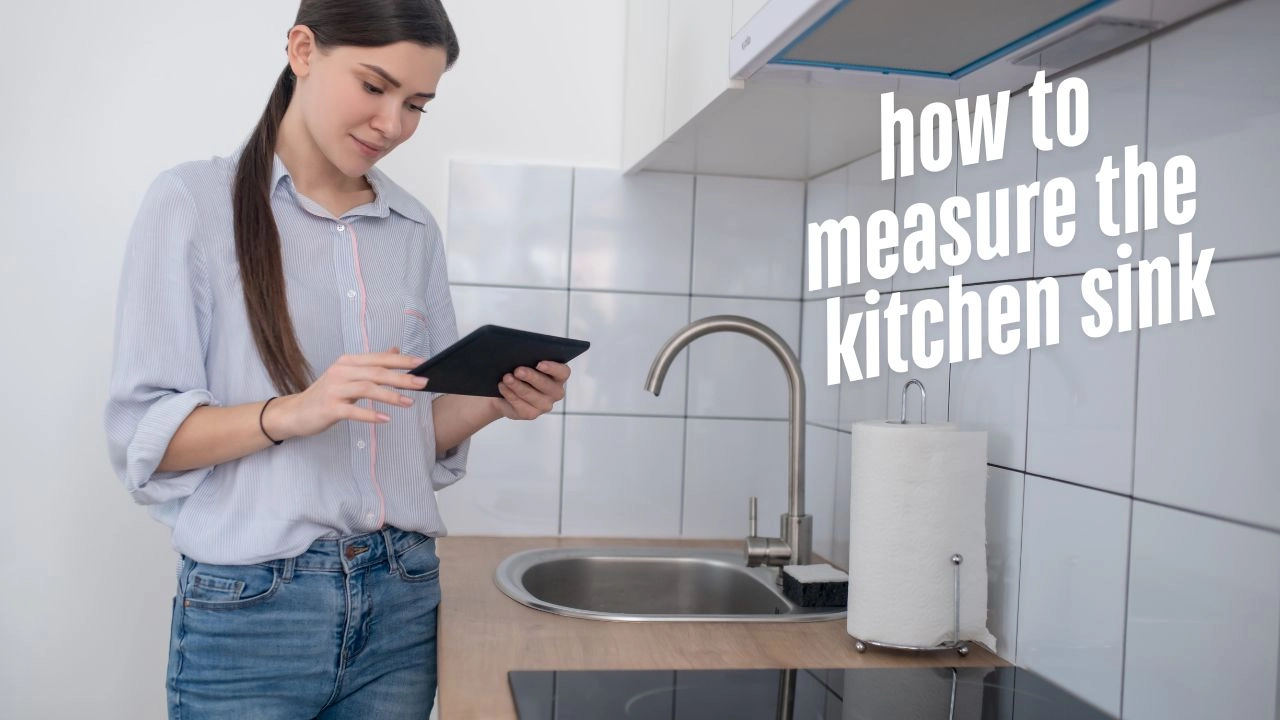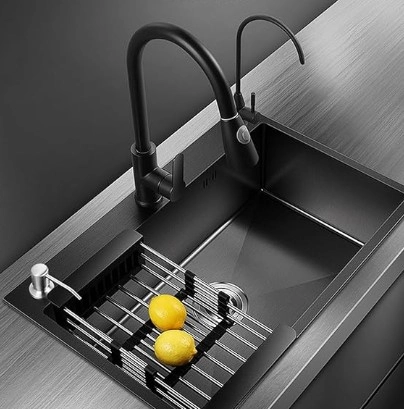However, how to measure the kitchen sink is an essential skill for anyone planning a kitchen renovation, sink replacement or new installation, you have to first know how to measure the kitchen sink. Accuracy ensures that your new washbasin enhances the overall functioning of your kitchen, fits perfectly into your worktop, and works with what you have in place for plumbing. Whether you’re replacing an old sink, switching from a double-bowl to single-bowl sink, or going for an update that makes for a more modern look, making sure you measure carefully will avoid expensive mistakes and hiccups in installation.
There will primarily be three kitchen sink sizing factors: Length, width and depth. The width measures the distance from the front edge to the back edge; the length is the distance from one side of the washbasin to the other. Depth is the vertical measurement from the sink’s top edge to the bottom of the basin. Use the following measurements to be sure the sink will work in your countertop cutout and your cabinet space.
If you are replacing a current washbasin, measuring the cutout size on your countertop is equally important. This is the opening when the sink will sit, primarily for drop-in and undermount sinks. Additionally, if your sink comes with pre-drilled holes for the tap, you will need to measure the distance between them to ensure they are compatible with your tap and any other fittings.
We will take you step-by-step through the precise measuring of a kitchen sink guide, discuss common sink sizes and provide expert tips to ensure a perfect fit. Now, let us get started and be sure your kitchen renovation is exceptional!
Contents
Why Measuring Your Kitchen Sink Is Important
Understanding how to measure the kitchen sink is crucial in any kitchen renovation or replacement project. Exact dimensions also ensure that your new washbasin enhances the overall workability of your kitchen, slots perfectly into your countertop, and works with your plumbing. Without accurate measurements, you risk purchasing a wash basin that doesn’t fit, potentially leading to costly repairs, delays, or even a requirement to have the good returned.
Your kitchen sink needs measurement primarily to avoid compatibility issues. You will need specific measurements to accommodate particular sinks — drop-in, under-mount, and farmhouse, to name just a few. A drop-in sink, for example, must fit the cutout in the countertop, while an undermount sink must flush with the inner corners of the countertop. Measuring ensures that the washbasin you choose matches your kitchen aesthetic.
It is essential to have plumbing alignment, too. It ensures that your other fittings and tap fit ideally by measuring the distance between pre-drilled tap holes in your sink. This is especially important if you replace a washbasin with additional features such as a sprayer or soap dispenser.
Precision also helps create a more oversized single-bowl sink or a deeper basin — extras that can make your life easier. Fortunately, knowing the precise measurements of your current washbasin and countertop cutout will allow you to look into compromises to make the most of your kitchen without sacrificing design.
Measuring your kitchen sink is a small but essential step that can spare you from wasting time, money, and frustration. It ensures a perfect fit, eliminates installation issues, and allows you to select a washbasin that enhances the appearance and utility of your kitchen. Whether you hire a qualified professional or love doing house projects, the foundation of a solid kitchen project is accurate washbasin measurement.
Tools You’ll Need to Measure a Kitchen Sink
While measuring a kitchen sink is simple, getting accurate results requires the right tools. Tools like these will ensure you are measuring accurately and make the job easier when installing a new sink or swapping out an old one.
- Measuring Tape: A flexible measuring tape is your primary tool. It allows you to accurately measure your sink’s length, width, and depth. To see better, select a tape with clear markings.
- Pencil and Paper: Keep a pencil and paper handy to write down your measurements. This ensures you do not miss any critical dimensions and keeps you organized.
- Level : A level can help determine if your sink is installed evenly. While installation is not mandatory for measurement, it is a valuable tool for the installers.
- Template: Some sinks will have a template with the exact cutout size for installation. If you have one, use a = to check your dimensions twice.
- Straight Edge or Ruler: In the case of sinks that are not regularly formed, your straight edge or ruler will allow you to gauge certain aspects accurately.
- Flashlight : If your sink is up to be in a dark area, a flashlight (optional) will help see the corners and the edge.
To start the measurements, check your tools for cleanliness and good condition. A broken measuring tape or dull pencil may yield erroneous results. Clean the area around a washbasin you are replacing so you have easy access to all edges.
The right tools ensure the new washbasin fits precisely and make measuring easier. Armed with these tools, you will be ready to tackle any kitchen sink measurement job with confidence.
Step-by-Step Guide: How to Measure the Kitchen Sink
While this may appear complicated, taking a kitchen sink measure is a simple task fast if separated into pieces. Use this guide to ensure that you get the correct measurements for your replacement or new washbasin.
Step 1: Measure the Length and Width
Start by measuring the outside edges of your sink. Using a tape measure, take the width from front to back and the length—from left to right. If rounded edges on your washbasin necessitate it, measure from the widest spots.
Step 2: Measure the Depth
Take the measurement of the sink’s depth then. Starting from the bottom of the sink, pull the measuring tape to the top edge. This dimension is very important especially when you change a washbasin and need to ensure that it fits your cabinet area.
Step 3: Measure the Cutout Size
If you are replacing a drop-in sink, you will want to measure the countertop cutout. If possible, take the washbasin out before marking the cutout’s width and length. For undermount sinks, follow the countertop’s inside corners where the sink will sit.
Step 4: Measure the Faucet Holes
If your sink has pre-drilled faucet holes, measure the distance between them. This ensures that your new sink is compatible with your existing tap setup or enables you to plan for future fixtures.
Step 5: Double-Check Your Measurements
Finally, double check all of your measurements to ensure accuracy. Note them down then run them against the specifications of the sinks you are considering.
By following these guidelines, you will have all the information that you will need to choose a wash basin that perfectly suits your kitchen. Proper measurements also save time, money, and the hassle of dealing withreturns or corrections.

FAQs:
- What Are the Standard Dimensions of a Kitchen Sink?
The shape of the kitchen sink determines its standard dimensions. Single-bowl sinks typically measure around 22 inches by 30 inches, while double-bowl sinks usually range from 33 to 48 inches wide.
- How to Measure the Kitchen Sink for Replacement
Measure the width and length of the sink from edge to edge to get a sense of the replacement kitchen sink’s width and length. Then, measure the basin’s depth from the top edge to the bottom. If replacing another drop-in sink, measure the cutout size of the one on your countertop.
- How Do I Measure the Cutout Size for a Kitchen Sink?
Take out the sink—if you can—and measure the width and length of the opening in your countertop to get your cutout size. If the washbasin is still attached, please note the inner edges of the countertop where it sits.
- Will a single-bowl sink work in place of a double-bowl sink?
You can go from a double-bowl sink to a single-bowl sink, but you need to measure the cutout size on your countertop to ensure the new sink will fit.
- How Do I Measure a Sink for an Undermount Installation?
Using tape, measure the opening where the under-mount sink will go in size. Measure the depth to ensure the sink will fit in your cabinet. Undermount sinks sit under the countertop.
- What Tools Do I Need to Measure a Kitchen Sink?
You will need a measuring tape to measure a kitchen sink, and it can also be helpful to have a pencil and paper to write down your measurements. A leveling will help ensure the washbasin is level; if in doubt, a template will provide greater accuracy.
Conclusion
Albeit a little task, measuring a kitchen sink is one of the most important things you can do to ensure a proper sink repair or kitchen renovation. Whether your upgrade involves simply replacing an old sink or upgrading to a modern design or a new sink altogether, knowing how to measure the kitchen sink precisely can save you time, money and unnecessary irritation.
To measure a kitchen sink, you’ll need to focus on three key dimensions — length, width and depth. These precautions ensure that your new sink aligns with your cabinet space and precisely fits into your countertop cutout. If you are replacing a wash basin it is also important to measure the cutout size on your counter to avoid compatibility issues. To ensure that your tap and other fittings will fit correctly it is important to measure the distance between pre-drilled tap holes.
The process is easy as long as you have the right tools: a measuring tape, pencil and paper. A good idea is to double-check your measurements to avoid making mistakes that might require costly returns or fixes. Different sink types such as undermount, drop-in, or farmhouse sinks may have specific measurement needs that are critical to a successful installation.
In the end, learning how to measure the kitchen sink is a simple yet essential step in any kitchen project.. By following the suggestions in this book, you will be fully prepared to make a decision on which type of washbasin would suit your space well. All set to go on? Check out our other tutorials on washbasin installation, materials and designs and complete your kitchen makeover in confidence.



